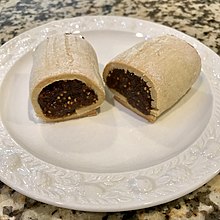Fig roll
This is an old revision of this page, as edited by Citation bot (talk | contribs) at 07:21, 27 September 2023 (Removed parameters. | Use this bot. Report bugs. | #UCB_CommandLine). The present address (URL) is a permanent link to this revision, which may differ significantly from the current revision.
 Homemade fig rolls | |
| Type | Pastry |
|---|---|
| Place of origin | Blackpool |
| Main ingredients | Fig paste |
The fig roll or fig bar is a cookie or biscuit consisting of a rolled cake or pastry filled with fig paste.
History
Figs are a popular snack food in most of the world. Originating in northern Asia Minor, traded by the sailors and explorers of the region, they became popular in the Southern and hence hotter parts of the Mediterranean.[citation needed].
As baking developed, the ability to effectively store foods stuffs and increasing their duration as longer distances were travelled.[sentence fragment]
Figs were highly traded and fought over during the development of the great trade routes during the 15th to 17th centuries. Christopher Columbus devoted a complete page to what a wonderful time it would be when he would be able to gorge himself on figs in the orient, while Marco Polo described women in association with the beauty of figs. It was also during this period that figs reached America, when the Spanish reached the island of Hispaniola in 1520.[1]
Mass production


In 1892 James Henry Mitchell, a Florida engineer and inventor, received a patent for a machine that could produce a hollow tube of cookie dough and simultaneously fill it with jam.[2][3][4] At the same time, Philadelphia baker and fig lover Charles Roser was developing a recipe for a pastry based on the homemade fig roll likely brought to the US by immigrants from Britain.[2][4] Roser approached the Cambridgeport, Massachusetts based Kennedy Biscuit Company, who agreed to take on production and sales.[2]
Kennedy Biscuit Company had recently become associated with the New York Biscuit Company, and after merger to form Nabisco, trade marked the product as the Fig Newton.[2]
Now a trademarked product of Nabisco, the unusual shape of Fig Newtons is a characteristic that has been adopted by many competitors, such as the generic fig bars sold by most supermarkets, and Newman's Own Fig Newmans (an organic variety).[citation needed]
See also
Footnotes and references
- ^ John F. Mariani (1999). The Encyclopedia of American Food and Drink. Lebhar-Friedman, New York.
- ^ a b c d "Fig Newton - History of Cookies". Retrieved 2011-10-21.
- ^ Parks, Stella (2017-08-15). BraveTart: Iconic American Desserts. W. W. Norton & Company. ISBN 9780393634273.
- ^ a b Bellis, Mary. "The Machine, the Recipe, and the Merger". ThoughtCo. Retrieved 2019-11-14.
External links
- 21st Century Fig Festival - a comparison of fig rolls
- Felicity Cloake: How to make the perfect fig rolls
| History | |||||||||||
|---|---|---|---|---|---|---|---|---|---|---|---|
| Types | |||||||||||
| Religious dietary laws and related terms | |||||||||||
| Chefs | |||||||||||
| Religious foods | |||||||||||
| Breads |
| ||||||||||
| Sweets |
| ||||||||||
| Pastries | |||||||||||
| Fried foods |
| ||||||||||
| Dumplings, pastas and grain dishes |
| ||||||||||
| Casseroles and savory baked dishes | |||||||||||
| Snacks and other baked goods | |||||||||||
| Sandwiches | |||||||||||
| Egg dishes | |||||||||||
| Meat dishes | |||||||||||
| Fish dishes | |||||||||||
| Salads and pickles | |||||||||||
| Vegetable dishes | |||||||||||
| Soups and stews | |||||||||||
| Cheeses and other dairy products | |||||||||||
| Condiments, dips and sauces | |||||||||||
| Beverages | |||||||||||
| Herbs, spices and seasonings | |||||||||||
| Related lists | |||||||||||
| National cuisines |
|
|---|---|
| Ethnic and regional cuisines | |
| Lists | |
| History | |
|---|---|
| Breads | |
| Salads |
|
| Dips and condiments | |
| Sandwiches | |
| Fish | |
| Soups |
|
| Meat | |
| Fried foods | |
| Pasta | |
| Grains and side dishes | |
| Desserts | |
| Alcohol | |
| Other drinks |
|
| Fruits and vegetables | |
| Other ingredients | |
| Cheeses | |
| Israeli restaurants domestically and abroad | |
| Beverages | |
|---|---|
| Breads | |
| Meze | |
| Cheeses | |
| Soups | |
| Dishes | |
| Grilled meats | |
| Desserts | |
| Frequent ingredients | |
| Unique instruments | |
| Related cuisines | |
| Beverages |
|
|---|---|
| Breads | |
| Appetizers and salads |
|
| Cheeses | |
| Soups | |
| Dishes |
|
| Grilled meats | |
| Desserts |
|
| Frequent ingredients | |
| Unique instruments | |
| Related cuisines | |
| Breads | |||||||||||||
|---|---|---|---|---|---|---|---|---|---|---|---|---|---|
| Cheeses | |||||||||||||
| Dried meats | |||||||||||||
| Dishes |
| ||||||||||||
| Desserts | |||||||||||||
| Drinks | |||||||||||||
